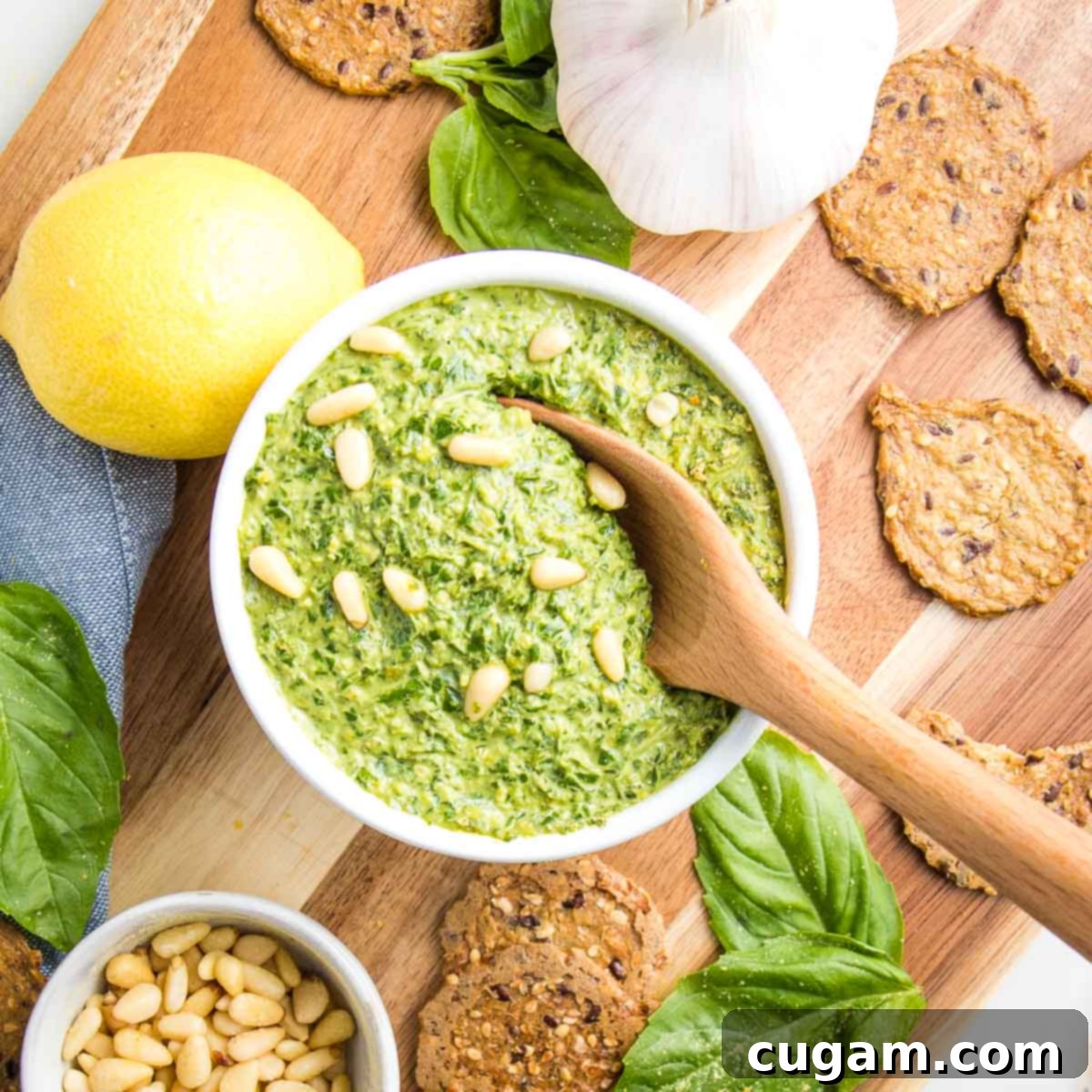Easy 5-Minute Vegan Basil Pesto: Dairy-Free & Delicious Homemade Recipe
Get ready to transform your meals with this incredibly easy and utterly delicious **5-Minute Vegan Basil Pesto Recipe**! Forget store-bought versions; making your own homemade pesto is not only simple but also yields a vibrant, fresh flavor that’s unbeatable. This dairy-free and highly versatile pesto is ideal for quick weeknight dinners, meal prepping, and it’s even freezer-friendly. Whether you’re tossing it with pasta, spreading it on pizza, adding it to sandwiches, or using it as a dip, this vegan pesto is a culinary game-changer you’ll want to keep on hand.
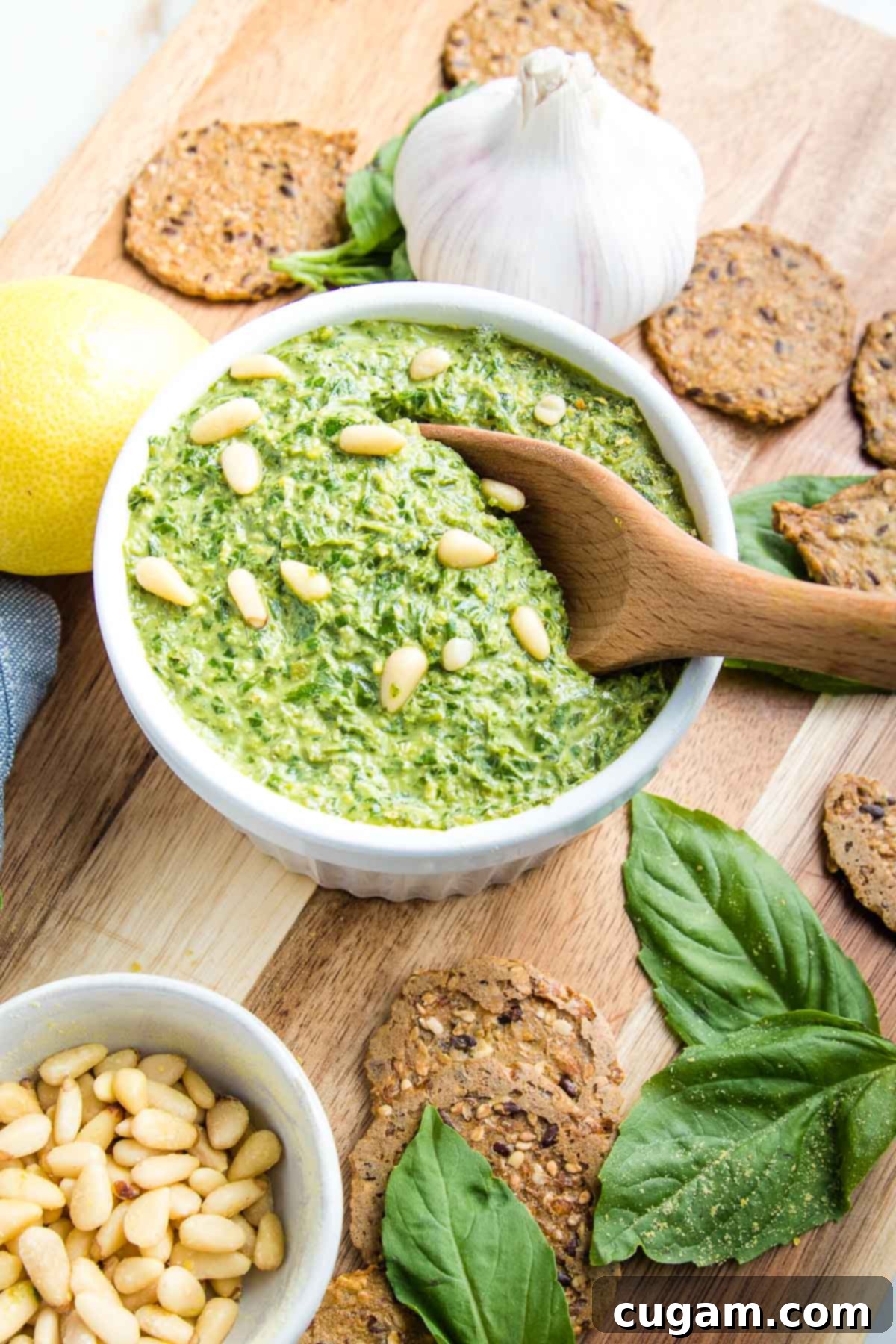
Jump to Recipe
Yes, you heard that right! A truly healthy pesto recipe that is completely dairy-free and absolutely bursting with flavor. Whether you’re harvesting fragrant basil from your garden or picking up a fresh bunch at your local farmers market, there’s nothing quite like the taste and aroma of a freshly made batch of vegan basil pesto. This recipe brings that farm-to-table freshness directly to your kitchen in mere minutes!
It’s no secret that I have a profound love for homemade pesto, and my blog is a testament to that, featuring a wide array of pesto variations. You’ll find unique recipes like kale pesto, zesty arugula pesto, savory dijon pesto, and even innovative carrot top pesto, alongside countless recipes that incorporate this beloved condiment. But it was time to share a classic, traditional basil pesto—reimagined! And don’t you worry, like all my recipes, this one is entirely dairy-free, plant-based, and tastes absolutely INCREDIBLE.
If you’re a pesto enthusiast or just starting your journey into homemade sauces, keep reading! I’m about to give you the inside scoop on everything pesto-related. From understanding what pesto truly is, to mastering the art of making the best vegan version, this guide is packed with tips and tricks. By the end, you’ll be an expert pesto maker, ready to impress with your culinary skills.
Why You Will Love This Easy Vegan Basil Pesto
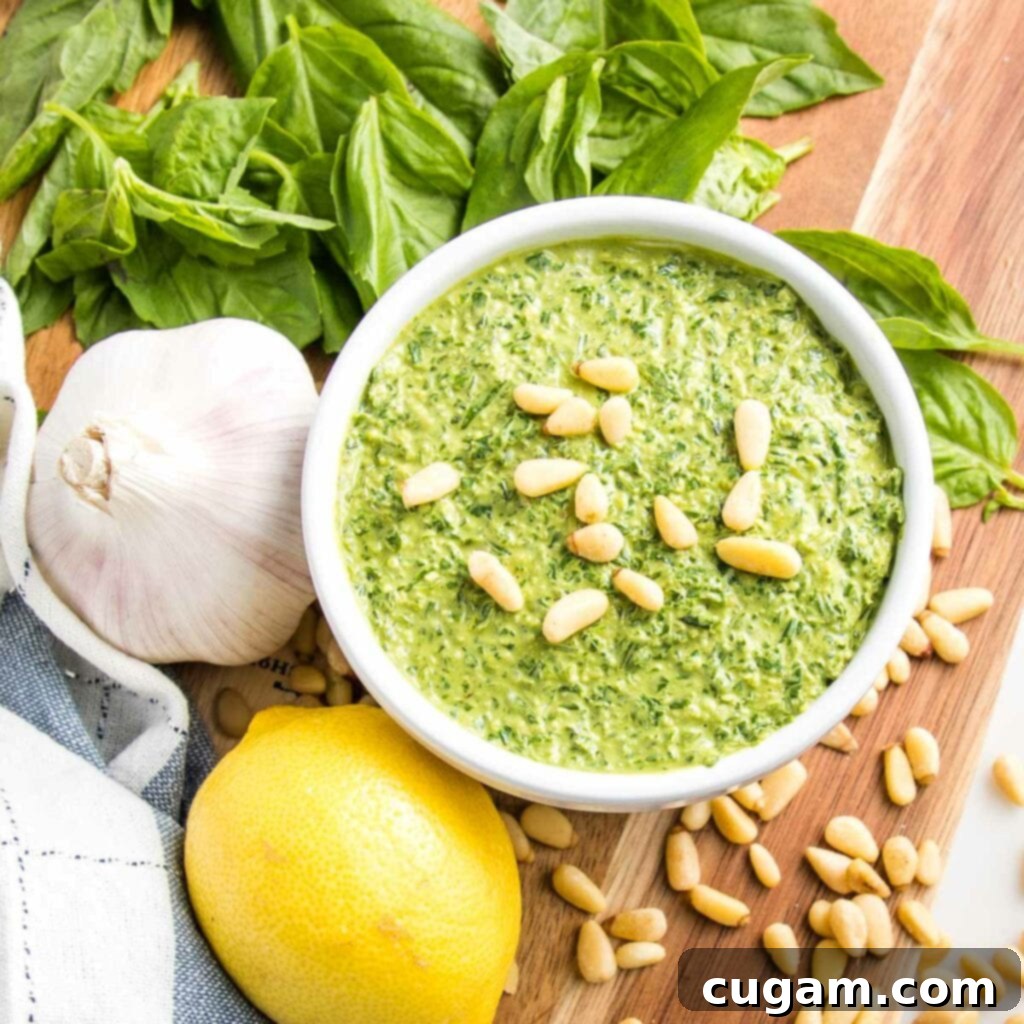
- Unbelievably Delicious & Dairy-Free: Enjoy all the rich, herbaceous flavor of traditional pesto without any dairy, making it perfect for plant-based diets and those with allergies.
- Super Easy and Fast: This recipe lives up to its “5-minute” promise! It’s so quick to whip up that you’ll wonder why you ever bought pesto from a jar.
- Budget-Friendly: Making pesto at home is significantly less expensive than purchasing premium store-bought versions, especially when basil is in season.
- Incredibly Versatile: This pesto is a culinary chameleon! Use it as a vibrant sauce for pasta, a flavorful spread for pizza, a dressing for roasted vegetables, or as a base for marinades.
- Perfect for Snacking & Entertaining: Serve it with crudités, crackers, or as a sophisticated dip on your charcuterie board for an instant crowd-pleaser.
- Enhance Wraps & Rolls: Slather a generous amount on your favorite wraps, sandwiches, or even spring rolls for an extra burst of fresh flavor.
- Meal Prep & Freezer Friendly: Prepare a large batch and store it in the fridge for up to a week, or freeze it in individual portions for an instant flavor boost whenever you need it.
What is Pesto? A Brief History and Modern Twist
Generally speaking, the term “pesto” often refers to the iconic “pesto alla genovese,” named after the beautiful city of Genoa in Italy, where this culinary masterpiece originated. Traditionally, authentic Genoese pesto consisted of a harmonious blend of fragrant garlic, delicate pine nuts, vibrant basil leaves, coarse sea salt, and a hard cheese like Pecorino Sardo or Parmigiano Reggiano, all emulsified with rich olive oil. The very term “Genoese” (or *pestare* in Italian) means “to pound” or “to crush.” Before the advent of modern food processors, this aromatic paste was meticulously created by hand using a sturdy marble mortar and a robust wooden pestle, a labor of love that brought out the purest flavors of each ingredient.
Today, the world of pesto has beautifully evolved. While the classic basil and pine nut combination remains a favorite, modern pesto recipes embrace creativity and dietary preferences. They can feature all sorts of fresh herbs or leafy greens (like kale, arugula, or cilantro), a variety of nuts or seeds (such as walnuts, cashews, or pumpkin seeds), and often, garlic, cheese, and oil are optional, or substituted. What all these diverse pesto recipes share, however, is the fundamental technique: the ingredients are meticulously pounded or ground into a smooth, flavorful paste. After that, the culinary canvas is yours! The more unique and vibrant flavors you can add with different herbs, aromatics, and spices, the better your pesto will be.
Essential Ingredients & Smart Substitutions for Vegan Pesto
Crafting the perfect vegan basil pesto relies on a few key ingredients, but don’t fret if you’re missing something! This recipe is incredibly adaptable. Here’s a detailed look at what you’ll need and how you can easily make swaps to suit your taste or dietary needs.
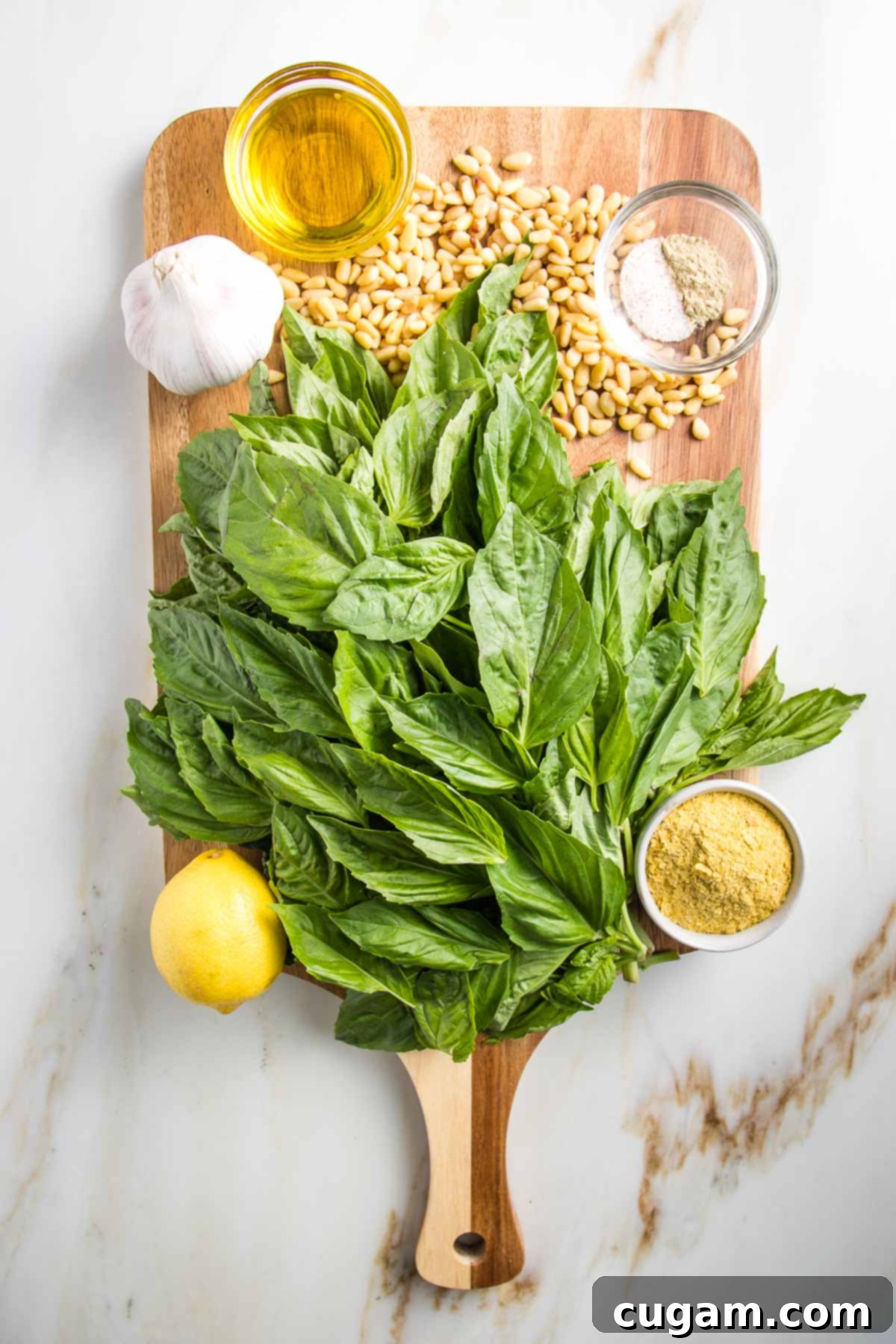
- Fresh Basil: The star of the show! Basil pesto offers a unique, sweet, and peppery aroma that sets it apart. You’ll need a generous amount, about 3 cups packed. If you find yourself a bit short on basil, don’t worry. You can supplement it with other fresh, aromatic herbs like parsley, oregano, or cilantro to reach the required volume. Arugula also works wonderfully, contributing a pleasant peppery kick that complements the basil. While spinach can be used, it’s generally too mild and watery to be the primary green for a flavorful pesto.
- Pine Nuts: Traditionally, pine nuts are preferred for their soft texture and delicate, buttery flavor, which results in an incredibly creamy pesto. However, many alternatives work beautifully. Cashews offer a similar creamy consistency and a mild flavor. For a gourmet twist, try marcona almonds; while seemingly counter-intuitive for a “soft” nut, they yield an absolutely delightful and flavorful pesto. If you need a nut-free option, a combination of hemp seeds and pumpkin seeds is my top recommendation, providing a great texture and nutritional boost. Sunflower seeds are also a good, accessible nut-free alternative.
- Garlic: Fresh garlic provides that essential pungent depth to pesto. For those following a Low FODMAP diet or who are sensitive to raw garlic, a fantastic alternative is garlic-infused olive oil. It imparts all the wonderful garlicky flavor without the potential digestive irritation. Alternatively, you can lightly roast a few cloves of garlic before adding them for a mellower, sweeter garlic note.
- Lemon: Fresh lemon juice and zest are crucial for adding a bright, tangy lift that balances the richness of the oil and herbs. Always zest the peel before juicing to capture that intense citrus flavor. If fresh lemons aren’t available, you can use ¼ cup of bottled lemon juice, though fresh is always preferred. In a pinch, 1-2 tablespoons of white vinegar can provide a similar zing and acidity.
- Extra Virgin Olive Oil: This recipe uses just ¼ cup of olive oil, making it lighter than many traditional recipes. If you’re looking to avoid added oils altogether, there are excellent substitutions. Plain water won’t give the same depth of flavor, so I highly recommend using vegetable broth as a better liquid base. To compensate for the creaminess that olive oil provides, add 2 tablespoons of hemp seeds; they blend beautifully and create a silky smooth texture. I’ve made oil-free pesto this way many times, and honestly, most people can’t tell the difference!
- Nutritional Yeast: This is my secret weapon for achieving a “cheesy” flavor in vegan recipes without any dairy. It took me a while to embrace this ingredient, but now I use it in everything from stuffed mushrooms to roasted broccoli. Nutritional yeast is widely available at most grocery stores or can be ordered online from retailers like Thrive Market or Amazon. I recommend buying a large container if you plan to use it often!
- Sea Salt: Seasoning is always a matter of personal preference. If you’re monitoring your sodium intake, try making the pesto without salt first, then taste and adjust. Adding a little extra garlic or lemon juice can boost flavor without adding sodium. You can also explore salt-free seasonings like Mrs. Dash.
- Pepper: I particularly love white pepper for its subtle heat and nuanced flavor that blends seamlessly without visible flecks. However, black pepper is a perfectly suitable substitute. For those who crave a more robust spice, sprinkle in a pinch (or more!) of crushed red pepper flakes to taste at the end.
How to Make 5-Minute Vegan Basil Pesto: Step-by-Step
You are going to be absolutely amazed at how incredibly simple it is to make fresh, homemade pesto from scratch. Honestly, it’s so quick and effortless that you’ll likely regret not having started sooner. Here’s how you do it:
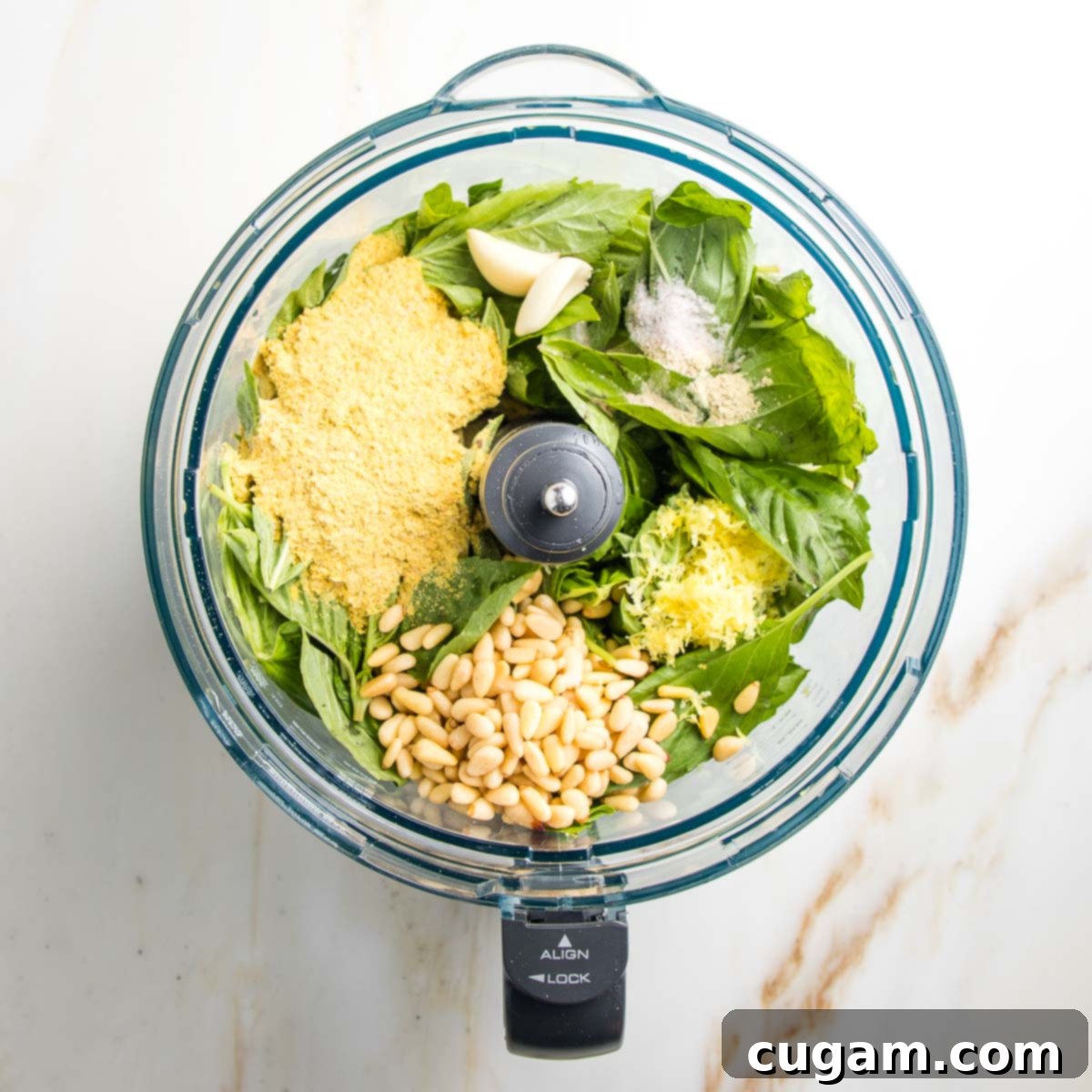
- Combine Dry Ingredients: Begin by adding your fresh basil leaves, pine nuts, nutritional yeast, garlic cloves, lemon zest and juice, sea salt, and pepper into the bowl of a food processor. If you don’t have a food processor, a high-speed blender will also work effectively. For a truly traditional (and arm-strengthening) method, you could use a mortar and pestle, but be prepared for a bit more effort!
- Pulse to Uniformity: Pulse the ingredients until they are uniformly chopped into small, consistent pieces. This step is crucial before adding any liquid, ensuring a smooth texture. Stop the processor and use a spatula to scrape down the sides of the bowl, ensuring all ingredients are well incorporated for an even blend.
- Add Liquid & Emulsify: With the food processor running, slowly drizzle in the olive oil. If you’re opting for an oil-free version, start with ¼ cup of vegetable broth. Continue processing until a creamy, dairy-free pesto begins to form. Scrape down the sides again as needed. Then, add water (or more broth) one tablespoon at a time until you reach your desired consistency. For a thicker pesto perfect for dips, use less liquid. For a smoother sauce for pasta, thin it out a bit more. The texture is entirely up to you!
- Taste & Adjust Seasoning: Once the pesto reaches your preferred consistency, give it a taste. This is your moment to customize! Add more salt, nutritional yeast for an extra cheesy punch, lemon juice for brightness, or a dash more pepper if desired. Process once more to fully incorporate any added seasonings.
- Storage & Freezing: Transfer your freshly made pesto to an airtight container. To prevent the top from turning brown (due to oxidation from air exposure), press a small piece of plastic wrap directly onto the surface of the pesto before sealing the container. It will keep beautifully in the fridge for up to a week. For longer storage, freeze pesto in ice cube trays. Once frozen, pop the cubes out and transfer them to a freezer-safe zip-top bag. These convenient cubes are perfect for an instant flavor boost in sauces, spreads, and countless other recipes!
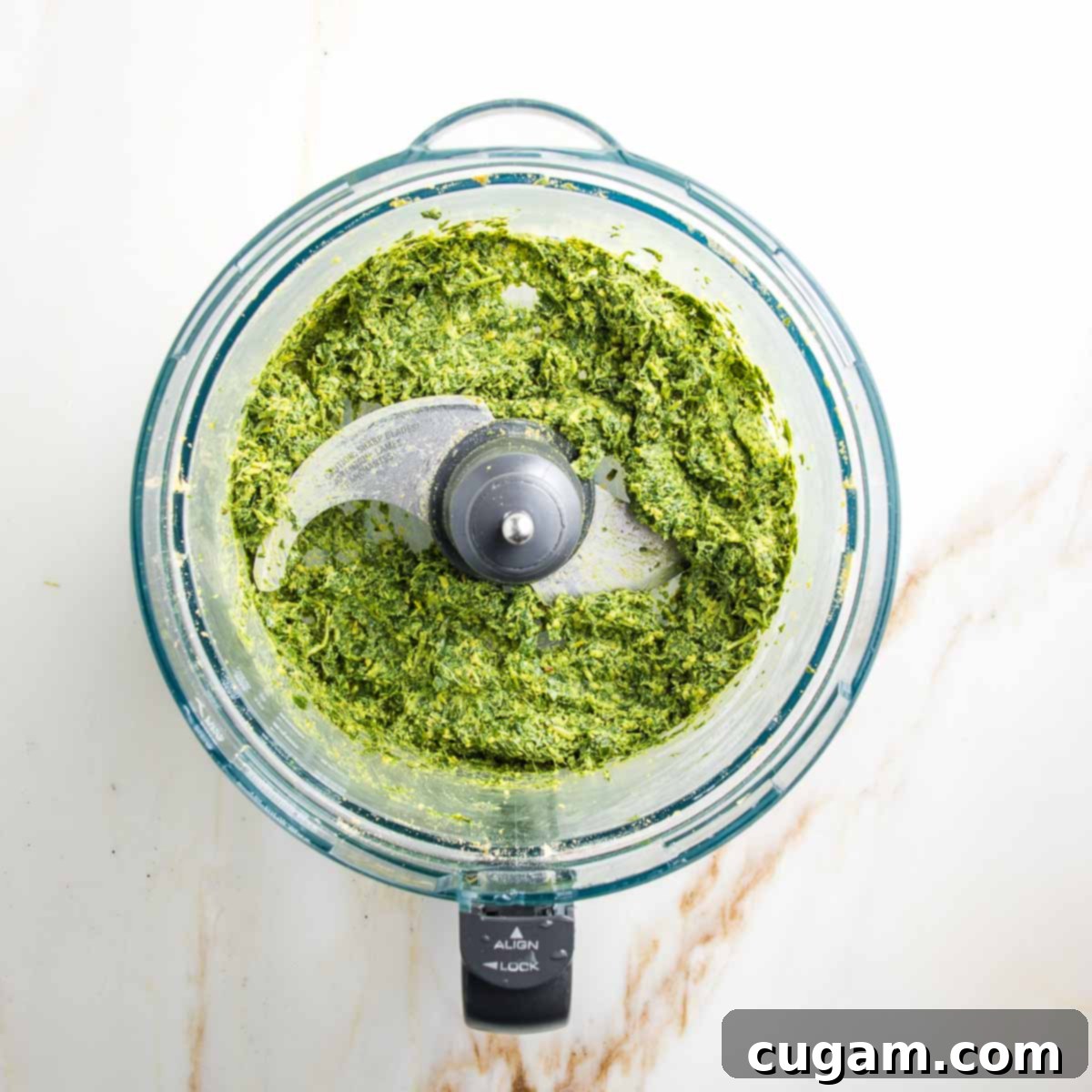
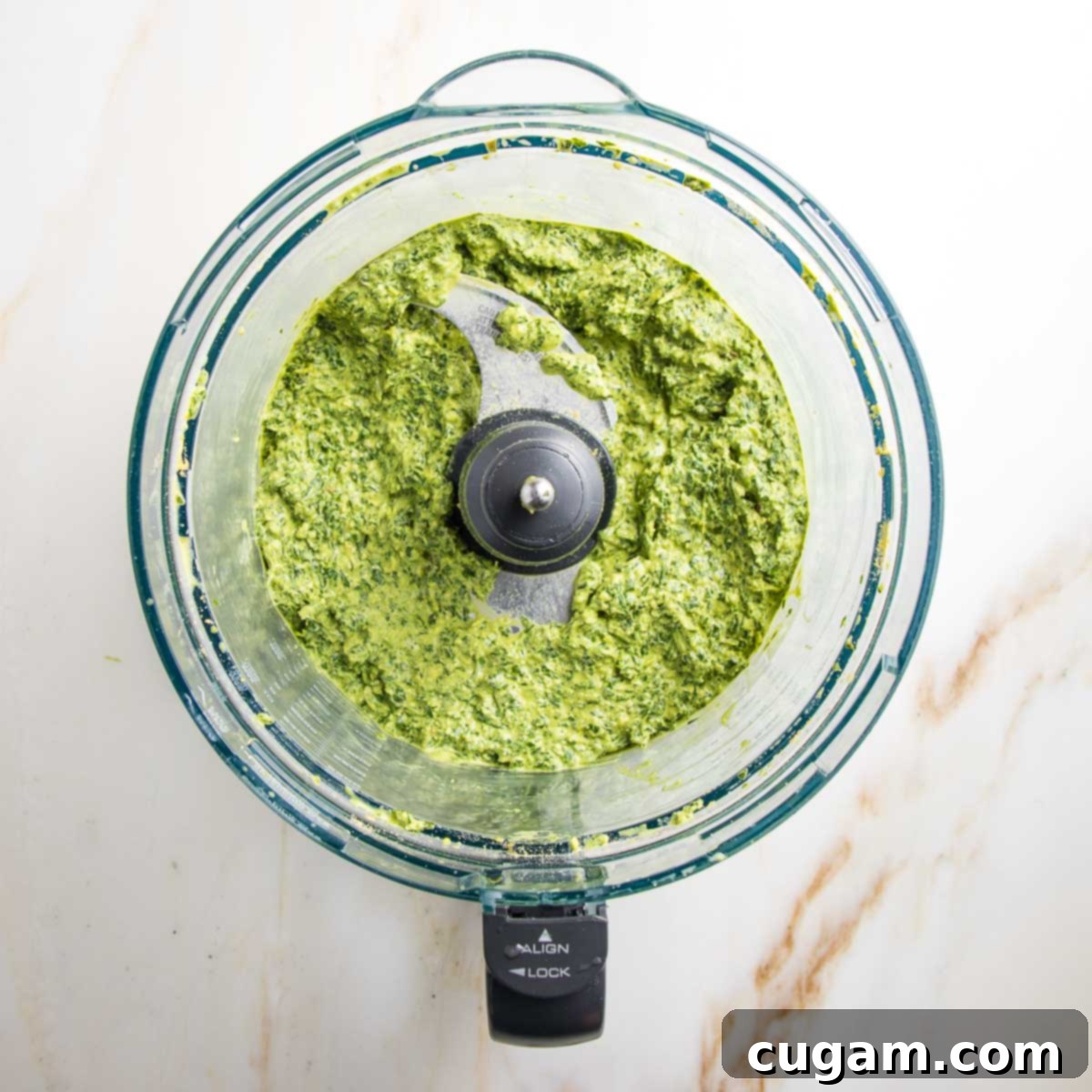
Debra’s Pro Tips for Perfect Pesto Every Time
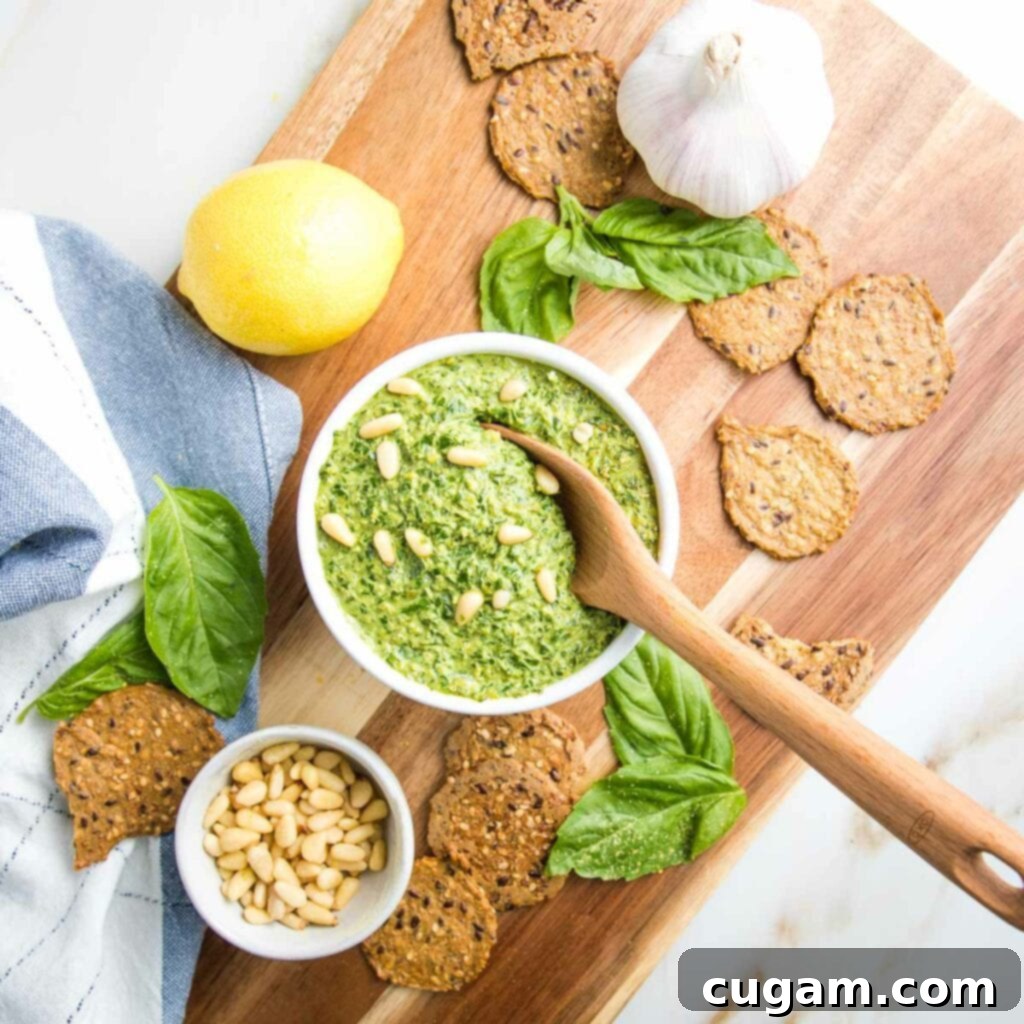
- Double Up for Future Meals: If you have an abundance of fresh basil, definitely make a double batch! This pesto freezes beautifully in ice cube trays. Once frozen, pop the cubes into a zip-top bag. You can then simply drop a pesto cube into any sauce, soup, or sautéed dish for an instant, vibrant flavor boost.
- Chop Dry Ingredients First: Always ensure you pulse and chop your solid ingredients (basil, nuts, garlic) into a uniform size *before* adding any liquid. This guarantees a smooth, consistent texture in your final pesto.
- Don’t Be Afraid to Mix Herbs: If your basil supply is a little low, don’t hesitate to use a combination of basil and other aromatic herbs like fresh parsley or oregano. This can create unique and equally delicious flavor profiles.
- Prevent Browning with Plastic Wrap: To keep your pesto looking its best and prevent the top layer from oxidizing and turning brown, place a piece of plastic wrap directly onto the surface of the pesto, ensuring it touches every part. Then, cover your container with a lid. This simple step makes a big difference!
- Grow Your Own Basil: Consider planting extra basil in your garden, or keep a pot of it in a sunny kitchen window. This way, you’ll always have fresh basil on hand to whip up this amazing pesto whenever inspiration strikes.
- More Basil? More Recipes! If you still have fresh basil after making your pesto, I highly recommend using it to whip up a batch of my delightful Basil Balsamic Vinaigrette. It’s another fantastic way to enjoy this aromatic herb.
Finding Your Best Pesto Recipe: Customization is Key
The “best” pesto recipe is truly subjective and depends entirely on your personal preferences, your dietary needs, and how you plan to use it. That’s the beauty of making pesto from scratch – it’s incredibly customizable! Consider these factors when crafting your perfect batch:
- What ingredients do you have on hand? The wonderful thing about pesto is its flexibility. Don’t let a missing ingredient stop you. As detailed in the “Ingredients and Substitutions” section above, there’s almost always a creative way to make it work with what’s available in your pantry.
- How will you use your pesto? The intended use can dictate the ideal consistency and flavor profile. If you’re making a creamy pesto pasta salad, you’ll likely want a smoother, slightly thinner consistency. For slathering over crispy smashed potatoes, a thicker, more intensely flavored pesto might be preferred. A pesto destined for roasted veggies will require a different consistency than a rich, dippable pesto for a charcuterie board.
- Who will be enjoying it, and are there any dietary restrictions? This is where homemade pesto truly shines. It’s incredibly easy to tailor this recipe to be completely dairy-free, oil-free, or nut-free without sacrificing taste or satisfaction. My extensive list of swaps below empowers you to customize this recipe to fit any dietary needs, ensuring everyone can enjoy an epic batch of healthy, flavorful pesto.
More Irresistible Sauces, Dips, and Spreads You Will Adore
- Baba Ganoush with Roasted Garlic and Tahini
- Green Tahini Sauce
- Easy Vegan White Bean Dip with Garlic and Herbs
- Creamy Tahini Caesar Dressing Recipe (vegan)
Did you know commenting and rating recipes is one of the best ways to support your favorite food bloggers? If you made this recipe, please consider giving it a five-star rating below and leave a comment sharing your experience! Also, please share your photos on instagram by tagging me @dkhealthcoach and using the hashtag #debraklein so I can see your delicious creation!
📖 Recipe
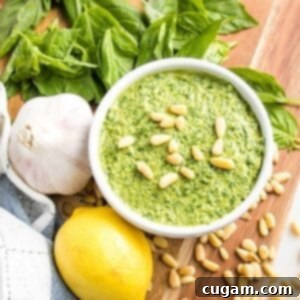
Vegan Basil Pesto
Debra Klein
Rate this Recipe
Pin Recipe
5 minutes
5 minutes
Condiment, Sauce
Italian
1 cup pesto
104 kcal
Equipment
-
Citrus Squeezer
-
Microplane
-
Food Processor
-
Silicone spatula
-
Measuring Cups and Spoons Set
Ingredients
- 3 cups 7.5 oz packed fresh basil leaves* (remove large stems before measuring)
- ¼ cup pine nuts*
- ¼ cup nutritional yeast
- 2 large cloves garlic
- 1 lemon zested and juiced
- ½ teaspoon sea salt
- ½ teaspoon white pepper*
- ¼ cup olive oil*
- 2-4 Tablespoons water*
Instructions
-
Add basil, pine nuts, nutritional yeast, garlic, lemon zest and juice, salt and pepper to the bowl of a food processor or blender. Process until everything has been uniformly chopped into small pieces.
-
Scrape down the sides of the bowl and process again, ensuring all ingredients are well combined.
-
Slowly drizzle in the olive oil (or your chosen liquid like vegetable broth) while the machine is running. Continue to process until a creamy consistency is achieved. Scrape down the sides once more. Add water (or additional broth) 1 Tablespoon at a time until your desired consistency is reached. For a thicker dip, use less liquid. For a smoother sauce, thin it out more. This step is entirely up to your preference!
-
Taste for seasoning. Adjust with more salt, nutritional yeast, lemon juice, or pepper as desired to suit your palate. Process once more to fully incorporate any added flavors.
-
Pesto will stay fresh in the fridge for up to a week when stored properly. To prevent the top from turning brown due to oxidation, place a piece of plastic wrap tightly and directly against the surface of the pesto, then cover with a lid.
-
For longer storage, freeze pesto in ice cube trays. Once completely frozen, pop the cubes out and transfer them to freezer-safe zip-top bags. These frozen pesto cubes are perfect for quick additions to sauces, spreads, and various other recipes, offering an instant boost of flavor without any waste.
Notes
NUTS: Pine nuts create a classic texture, but marcona almonds are a truly delicious substitute for a unique flavor profile. For a nut allergy-friendly pesto, substitute the nuts with toasted pumpkin seeds or sunflower seeds for a similar texture and richness. You can also use cashews for a creamy consistency, or walnuts for a more earthy flavor.
WHITE PEPPER: I prefer white pepper for its subtle heat and ability to blend seamlessly without visible flecks. If you prefer less spice, reduce the white pepper to ¼ teaspoon. For those who enjoy a spicier kick, taste the finished pesto and add a pinch (or more!) of crushed red pepper flakes, then process again to combine.
FOR NO OIL PESTO: For an oil-free version, you’ll need approximately ½ cup of total liquid, combining water and/or vegetable broth. Instead of all plain water, I highly recommend using vegetable broth to provide more depth of flavor. Start with ¼ cup of liquid, process, then add another 2 Tablespoons, and process again. After that, add liquid 1 Tablespoon at a time until your desired consistency is achieved. Additionally, if you’re omitting oil, add 2 Tablespoons of hemp seeds to compensate for the creamy texture and richness that oil typically provides.
Nutrition
Calories: 104kcal
Carbohydrates: 3g
Protein: 3g
Fat: 10g
Saturated Fat: 1g
Polyunsaturated Fat: 8g
Sodium: 136mg
Fiber: 1g
Note
The nutrition calculations were done using online tools. To obtain the most accurate representation of the nutritional information in any given recipe, you should calculate the nutritional information with the actual ingredients you used. You are ultimately responsible for ensuring that any nutritional information is accurate, complete and useful.
Did you make this recipe? Please leave a review below, then snap a picture and tag me @dkhealthcoach or use hashtag #dkhealtcoach on Instagram so I can see it!!
